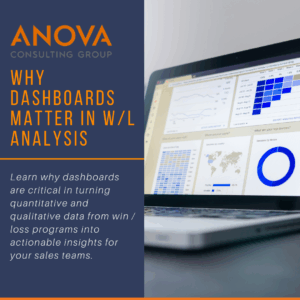Wednesday, October 8, 2025
Why Dashboards Matter in Win/Loss Program
 This blog was written by Philip Trevisan, Consultant at Anova.
This blog was written by Philip Trevisan, Consultant at Anova.
In an increasingly quantitative world, nearly every program we use spits out data in some form. Sales leaders naturally want to wrangle that raw data into something digestible – and one of the most common ways is on a dashboard. Before entering the market research space, I worked in management consulting, where I saw clients frequently ask for dashboards to help them make sense of complex, disparate, or overwhelming amounts of data. Oftentimes, they just wanted to see their data displayed – but dashboards are important for so much more than that.
Dashboards are a core part of a successful Win / Loss program. Beyond just displaying quantitative data in an easy-to-understand way, they offer several larger benefits:
- Dashboards foster transparency and equal access
- When a whole team uses a shared Win / Loss data dashboard, everyone operates on the same page. A shared dashboard fosters transparency and equal access – there is room for interpretation and discussion of the data, but your entire team is basing these conversations on a shared, universal set of information.
- Dashboards focus your team on improvement
- A well-designed Win / Loss dashboard gives your team immediate insights on how to improve. It is difficult to tease out actionable improvements from raw data – building a visual display of the information allows your team to immediately identify insights and areas for improvement in your sales process.
- Dashboards improve real-time decision-making
- When you get an unexpected request from a prospect or are trying to determine how you size up against a competitor before a meeting, well-designed dashboards give your team real-time data you can act on.
Successful dashboards have a few key characteristics. At Anova Consulting, we’ve built the myView dashboard, a web dashboard around these principles:
- Ensure it focuses on actionable data
- Successful dashboards drive your team to action and enable change. If a dashboard isn’t providing data that helps you act, then it’s just a medium for digital noise, overloading you and your team with another set of KPIs to monitor.
- Identify and display actionable metrics; for instance, key reasons your sales team are winning and losing, the most common reasons for your prospects’ decisions, and other areas that matter most to your team.
- When rolling up qualitative data into quantitative displays of information, ensure everyone is speaking a shared language – build a set of categories and priorities and stick with it.
- For instance, if a prospect shares they went with a competitor due to their willingness to negotiate on price, one of your teammates may identify that as a loss due to pricing, and another may identify it as a loss due to poor sales execution – neither are ‘wrong’, per se, but now your dashboard data are muddled.
- Make sure it updates in real-time – automate as much as possible
- In an increasingly fast-paced business environment, having access to real-time data that updates regularly is key for winning business. A dashboard that requires manual updating can quickly become outdated, potentially imperiling decisions that require the most up-to-date data.
- Explore automating data entry – uploading interview summaries that auto-populate the relevant charts, for example.
Interested in learning more?
Anova Consulting Group offers real-time insights on our clients’ Win / Loss programs through the myView dashboard, a secure web portal that provides our clients with real-time access to their research results. Click here to learn how myView can help your organization win more business.

 This blog was written by Philip Trevisan, Consultant at Anova.
This blog was written by Philip Trevisan, Consultant at Anova.